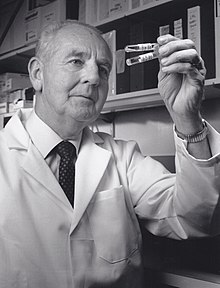Endotoxin
Endotoxins ( ancient Greek ἔνδον endon "inside", "inside", τοξίνη toxíne "poisonous substance") are a class of naturally occurring chemical compounds . They are the decay products of bacteria that can trigger numerous physiological reactions in humans.
definition
Endotoxins are a component of the outer cell membrane (OM = outer membrane) of gram-negative bacteria or cyanobacteria . Chemically, they are lipopolysaccharides (LPS), which are made up of a hydrophilic polysaccharide and a lipophilic lipid component . In contrast to the bacteria from which they originate, endotoxins are very heat-stable and even survive sterilization .
Word origin
The term endotoxin (as opposed to ectotoxin or exotoxin) is derived from the Greek endo = inside and toxin = poison , because its discoverer Richard Pfeiffer erroneously assumed that they would be released from inside the bacteria.
Effects
Endotoxins belong to the group of pyrogens , which means that they can cause a fever in humans and some animal species if they come into contact with mucous membranes and enter the blood . They also activate a number of signaling pathways in immunocompetent cells, which can lead either to inflammation or to programmed cell death ( apoptosis ) of these cells. They are already biologically effective in the lowest concentrations (lower pg / ml range). The LD 50 value for endotoxins is 200–400 µg per mouse (in comparison with this, exotoxins: LD 50 value of 25 pg). Endotoxins are primarily released during cell lysis , but in contrast to enterotoxins or exotoxins, they are not continuously released by living bacteria into the surrounding medium.
Evidence and determination
The most sensitive method for measuring endotoxin works via the activation of the coagulation cascade in the lysate from amebocyte that from horseshoe crabs ( Limulus polyphemus were isolated) (so-called. LAL test ). More modern methods meanwhile dispense with the use of animal components and use recombinantly produced proteins for the endotoxin determination, which are able to bind to the endotoxins and at the same time are able to generate a fluorescence signal by converting a substrate.
Destruction of endotoxins
Heat-resistant devices can be freed of the endotoxins in 5 hours at 200 ° C, and non-heat-resistant devices with 1 molar sodium hydroxide solution , which should act for 15 hours.
Web links
- Endotoxins - Effect and Methods of Detection
- A. Kolk: Method for determining the endotoxin concentration in the air at the workplace [1] .
